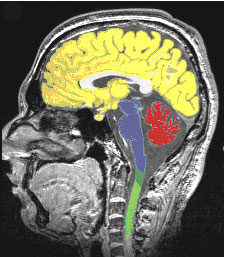About the Cerebellum
There are three parts of the brain: the cerebrum, the cerebellum, and the brain stem. The cerebrum is the largest part of the brain. It controls movements and thoughts and is responsible for helping you see, hear, smell, and touch. The brain stem lies beneath the cerebrum and in front of the cerebellum and connects to the spinal cord, which runs through the spine, giving and receiving nerves from the arms and legs.
The cerebellum, located at the back of the brain below the cerebrum, is about one-eighth of the size of the cerebrum. It is responsible mainly for coordination of movement, speech, and senses. The cerebellum may also play a part in other mental processes such as perception and cognition. When the cerebellum is damaged, a person usually experiences problems with balance and coordination of movements.
There are many types of cells that make up the cerebellum. The most important is called Purkinje cell, which gives out information from the cerebellum back to the cerebrum and also to the brain stem and spinal cord. Loss (death) of the Purkinje cell is the most common finding in cerebellar ataxia from any cause. The absence of a functioning Purkinje cell causes the cerebellum to shrink. This shrinkage can sometimes be seen through magnetic resonance imaging (MRI) scans. The Purkinje cell is quite sensitive to decreased blood flow, alcohol, and other toxins, including some medications. It is also sensitive to heat stroke. Thus, cerebellar ataxia may be a residual problem after recovery from heat stroke.

This MRI scan shows a midline section of the brain. The red area is the cerebellum, the yellow is the cerebrum, the blue area is the brain stem and the green area is the upper part of the spinal cord.
|

